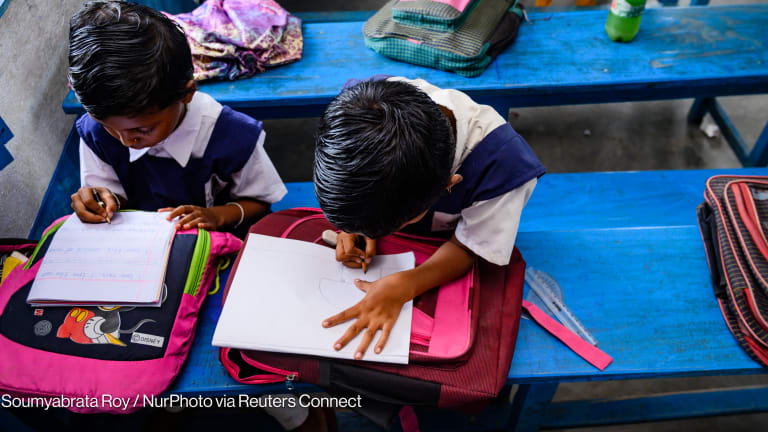South Africa: UK aid withdrawal prompts donor diversification
The U.K.’s decision to end bilateral aid to South Africa by 2015 underscores the growing need for implementing organizations — especially NGOs — to diversify their sources of funding. Devex learns how corporate donors can partially fill the void.
The U.K.’s decision to end bilateral aid to South Africa by 2015 underscores the growing need for implementing partners — especially NGOs — to diversify their sources of funding to fill the void left by cash-strapped traditional donors. The British Department for International Development’s announcement in May reflects a growing donor perception — that this emerging economy and donor nation no longer needs foreign aid. U.K. Secretary of State for International Development Justine Greening says the South African government, like the Indian government before, can now pretty much handle its own development challenges, and other donors seem to be on the same page. The United States is set to scale down its health footprint in South Africa with a reduced U.S. President’s Emergency Plan for AIDS Relief allocation in the next five years that could go down to as low as $250 million by 2017, a move that is sure to drive aid groups working in the HIV/AIDS sector to scramble for funds in a country that is a unique case in Africa: A regional economic powerhouse and middle-income nation that nevertheless still suffers substantial poverty. South Africa’s second largest donor, the European Union, has yet to reveal its spending plans for the next seven years, but there is a chance that South Africa could fall off Brussels’ list of priority countries, especially with the donor’s increasing focus on fragile states. All these potential scenarios make the case for NGOs — and all development implementers in general — in South Africa to end their reliance on donor governments as main funding sources. A growing alternative source is corporate social investment, a general trend for the development world as traditional donor budgets shrink or even disappear. Corporate social investment South African companies spent in 2012 about 6.9 billion rand (close to $700 million) on corporate social investment, according to a handbook released annually by Trialogue, a leading local consultancy firm focused on CSI. This figure is more than the almost $500 million PEPFAR provides every year for HIV/AIDS treatment and awareness in the country, and much more than the average $129 million the EU plans to spend until 2015. In fact, the amount that South African companies such as mining giant Anglo American, the FirstRand banking group and the South African Breweries contribute to development in the country makes the United Kingdom’s 14 million pounds — of which roughly 12 percent goes to NGOs — seem like a drop in the ocean. Such huge private investment in social development projects could have been driven by the broad-based black economic empowerment, which the new majority government introduced in 2004 to entice companies to give back to the community and invest in socio-economic development programs across South Africa after decades of white rule under the apartheid regime. But the sector is pretty diverse in terms of what and how they fund programs, according to Michael Rifer, who heads a consulting team at Tshikululu Social Investments, a non-profit that manages corporate foundations in South Africa. For instance, he explained, education is a top priority among South African companies, with more than 40 percent of CSI funding going to the sector. Some corporations, like Anglo American in the mining sector, are required by law to directly support community development initiatives, normally through a foundation or trust, but others manage their corporate social activities “entirely in-house.” “South African companies sort of see that as an investment in their future in this country. I think we are in a new place now where corporations in South Africa are looking at the long-term landscape and saying: For us to be viable, we need incomes to be thriving, we need our consumer base to be growing, we need the economy to be more diverse and competitive,” Rifer told Devex. Rounding up the top three are health, community welfare and development, which could mean money given to community-based groups that serve the needs of vulnerable populations, such as people with disabilities, or investing in capacity-building organizations. But Rifer also pointed out that CSI funding on health is “not as high a priority to corporations in South Africa as it is to the international donor community,” adding that corporations spend annually less than $100 million, or less than 20 percent of PEPFAR’s $500 million a year budget for South Africa on health. This focus on certain sectors could pose problems for local NGOs determined to win funding from businesses. Dumisani Mnyandu, an independent consultant with more than a decade of experience in fundraising and grants management in development, told Devex aid groups may be forced to focus on projects that they don’t have the capacity to deliver “just because they need money to cover other operational costs.” It doesn’t help that these days, he added, companies spend more time sifting through a high volume of applications, leading to further operational delays and high staff turnover rate among NGOs. Changing direction Whether corporations can fill the gap to be left by major donors planning to pull out of South Africa is too early to tell. None of the development professionals Devex spoke to feels strongly about this happening anytime soon. But organizations aiming to source funds from this sector ought to know this: Rifer said corporations and foundations are beginning to “operate more like development agencies.” What does that mean? That businesses are no longer just giving out money. The Ubuntu Education Fund, a nonprofit based in South Africa, receives funding from a wide array of sources: aid agencies such as Canada’s CIDA, the South African government, big and small corporations, and generous individuals who have some cash to spare. In 2012, the organization was able to raise a total of $5.4 million, according to its annual report. Some 20 percent of that money came from the South African private sector, from small manufacturing plants to Fortune 500 companies that have offices in the country, Ubuntu co-founder and President Jacob Lief told Devex. The organization is proud of its “cradle-to-career” business model, investing not only to ensure every child gets to finish college, but also checking on his health and security. Such a clear strategy and capability of showing evidence of its impact, Rifer argues, is what makes South African corporations and foundations tend to favor more established outfits like Ubuntu, which has almost 15 years of experience. “It seems to be getting to that direction: Favoring organizations that have better monitoring and evaluation systems, and that are sort of better able to demonstrate the value of their good work,” he said. “We’ve seen a shift in the last couple of years from a mentality that it’s kind of just good enough to be doing some good or be supporting a good cause to a place where now corporations are wanting to see more info and better information about the impact of work they are supporting.” That shift in mindset, Rifer explained, can be attributed in part to the growing consumer awareness across South Africa. Brand reputation and consumer-driven issues are “always” on the minds of local corporations. “They want to manage risks and exposure, and want to support organizations they know are doing good work, and not just assuming they are doing good work,” he added. ‘Doable’ work This increasing demand from corporations for more monitoring and evidence of NGO work could be a situation where well-established organizations such as Ubuntu — but not smaller, local aid groups — have an advantage. In the feedback Rifer has been getting from partner organizations, many raise the issue of procurement, monitoring evaluation and reporting requirements as “unfamiliar and sometimes unwelcome burdens.” World Vision South Africa head Paula Barnard agrees this could be a pain, especially for smaller aid groups, which may not have the capacity to deliver on such requirements. But she thinks it’s “doable” as long as one is “really focused on what they are doing.” Organizations should not be overpromising nor underdelivering about what they do, and be conscious of their own costs and spending patterns, Barnard notes, adding that spending should be kept “within reason.” Aid groups, she added, can start by looking at their operations: What they are doing with the money, and making sure they are delivering on exactly what donors expect them to. “Most would come with a set of requirements of what to do with the money and if they are really performing against those. Sometimes you will have to make hard decisions, about what parts of the program [you] need to let go, or in the evaluation of overhead, how you can do things better,” she said. “That’s austerity — a timeframe where not only private people, but also NGOs need to evaluate how they spend and where they are spending things on. It’s hard for everybody, large and small NGOs alike, but just a different ratio.” Rifer said Tshikululu has started to ask corporate clients if there’s still some space for “just giving” — supporting organizations that are just doing good work — as opposed to investing in a development program that needs rigorous monitoring and evaluation for impact. But NGOs, he said, need to also understand that the landscape is shifting, and that they, too, need to change. Read more development aid news online, and subscribe to The Development Newswire to receive top international development headlines from the world’s leading donors, news sources and opinion leaders — emailed to you FREE every business day.
The U.K.’s decision to end bilateral aid to South Africa by 2015 underscores the growing need for implementing partners — especially NGOs — to diversify their sources of funding to fill the void left by cash-strapped traditional donors.
The British Department for International Development’s announcement in May reflects a growing donor perception — that this emerging economy and donor nation no longer needs foreign aid. U.K. Secretary of State for International Development Justine Greening says the South African government, like the Indian government before, can now pretty much handle its own development challenges, and other donors seem to be on the same page.
The United States is set to scale down its health footprint in South Africa with a reduced U.S. President’s Emergency Plan for AIDS Relief allocation in the next five years that could go down to as low as $250 million by 2017, a move that is sure to drive aid groups working in the HIV/AIDS sector to scramble for funds in a country that is a unique case in Africa: A regional economic powerhouse and middle-income nation that nevertheless still suffers substantial poverty.
This story is forDevex Promembers
Unlock this story now with a 15-day free trial of Devex Pro.
With a Devex Pro subscription you'll get access to deeper analysis and exclusive insights from our reporters and analysts.
Start my free trialRequest a group subscription Printing articles to share with others is a breach of our terms and conditions and copyright policy. Please use the sharing options on the left side of the article. Devex Pro members may share up to 10 articles per month using the Pro share tool ( ).
Jenny Lei Ravelo is a Devex Senior Reporter based in Manila. She covers global health, with a particular focus on the World Health Organization, and other development and humanitarian aid trends in Asia Pacific. Prior to Devex, she wrote for ABS-CBN, one of the largest broadcasting networks in the Philippines, and was a copy editor for various international scientific journals. She received her journalism degree from the University of Santo Tomas.








